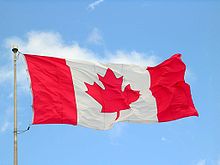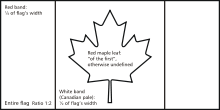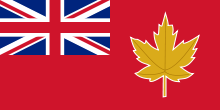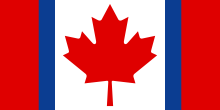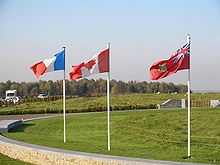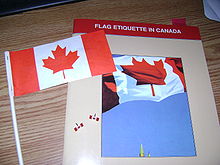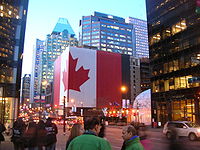- Flag of Canada
-
This article is about the National flag of Canada. For other Canadian flags see: List of Canadian flags
Flag of Canada
Name The Maple Leaf, l'Unifolié Use National flag and ensign 
Proportion 1:2 Adopted February 15, 1965 Design A vertical bicolour triband of red, white, and red, with a red maple leaf charged in the centre. Designed by George F. G. Stanley, John Matheson The national flag of Canada,[1] also known as the Maple Leaf, and l'Unifolié (French for "the one-leafed"), is a red flag with a white square in its centre, featuring a stylized 11-pointed red maple leaf. Its adoption in 1965 marked the first time a national flag had been officially adopted in Canada to replace the Union Flag. The Canadian Red Ensign had been unofficially used since the 1890s and was approved by a 1945 Order in Council for use "wherever place or occasion may make it desirable to fly a distinctive Canadian flag".[2][3]
In 1964, Prime Minister Lester B. Pearson appointed a committee to resolve the issue, sparking a serious debate about a flag change. Out of three choices, the maple leaf design by George F. G. Stanley and John Matheson based on the flag of the Royal Military College of Canada was selected. The flag made its first appearance on February 15, 1965; the date is now celebrated annually as National Flag of Canada Day.[4]
Many different flags have been created for use by Canadian officials, government bodies, and military forces. Most of these flags contain the maple leaf motif in some fashion, either by having the Canadian flag charged in the canton, or by including maple leaves in the design. The Royal Union Flag is also an official flag in Canada, used as a symbol of Canada's membership in the Commonwealth of Nations, and of its allegiance to the Crown. The Union Flag remains a component of other Canadian flags, including the provincial flags of British Columbia, Manitoba and Ontario.[5]
Contents
Design
The width of the Maple Leaf flag is twice the height. The white field is a Canadian pale (a square central band in a vertical triband flag, named after this flag), and each bordering red field is exactly half its size.[6] In the centre of the white field is a red maple leaf. In heraldry, the flag has been blazoned as "Gules on a Canadian pale argent a maple leaf of the first."[7] The blazon was registered with the Canadian Heraldic Authority on March 15, 2005.[8]
The maple leaf has served as a symbol celebrating the nature and environment of what is now Canada since the 18th century.[9] The number of points on the leaf has no significance.[10] The number and arrangement of the points of the maple leaf were chosen after wind tunnel tests showed the current design to be the least blurry of the various designs when tested under high wind conditions.[11] The image of the maple leaf used on the flag was designed by Jacques Saint-Cyr.[12] In 1921, King George V proclaimed the official colours of Canada as red, from Saint George's Cross, and white, from the French royal emblem since King Charles VII.[13]
The Department of Canadian Heritage has listed the various colour shades for printing ink that should be used when reproducing the Canadian flag; these include:[6]
- FIP red: General Printing Ink, No. 0-712;
- Inmont Canada Ltd., No. 4T51577;
- Monarch Inks, No. 62539/0
- Rieger Inks, No. 25564
- Sinclair and Valentine, No. RL163929/0.
The colours 0/100/100/0 in the CMYK process, PMS 032 (flag red 100%), or PMS 485 (used for screens) in the Pantone colour specifier can be used when reproducing the flag.[6] In 1984, the National Flag of Canada Manufacturing Standards Act was passed to unify the standards used for flying the flag both indoors and outdoors.[14]
History
See also: Great Canadian Flag DebateThe first flag known to have flown in Canada was the St George's Cross carried by John Cabot when he reached Newfoundland in 1497. In 1534, Jacques Cartier planted a cross in Gaspé bearing the French royal coat of arms with the fleurs-de-lis. His ship flew a red flag with a white cross, the national flag of France at the time. New France continued to fly the evolving French military flags of that period.[3][15]
The Royal Union Flag has been used in Canada since the 1621 British settlement in Nova Scotia. Since the surrender of New France to the United Kingdom in the early 1760s, the Royal Union Flag, called the Union Jack (or, less commonly, Union Flag) in the United Kingdom, was used as the de jure national flag, as in the United Kingdom, until the adoption of the current flag in 1965.[3]
Shortly after Canadian Confederation in 1867, the need for distinctive Canadian flags emerged. The first Canadian flag was the Flag of the Governor General of Canada, a Royal Union Flag with a shield in the centre bearing the quartered arms of Ontario, Quebec, Nova Scotia, and New Brunswick surrounded by a wreath of maple leaves.[16] In 1870 the Red Ensign, with the addition of the Canadian composite shield in the fly, began to be used unofficially on land and sea, and was known as the Canadian Red Ensign. As new provinces joined the Confederation, their arms were added to the shield. In 1892, the British admiralty approved the use of the Red Ensign for Canadian use at sea. The composite shield was replaced with the Coat of arms of Canada upon its grant in 1921 and, in 1924, an Order in Council approved its use for Canadian government buildings abroad.[3] In 1925, Prime Minister William Lyon Mackenzie King established a committee to design a flag to be used at home, but was dissolved before the final report could be delivered. Despite the failure of the committee to solve the issue, public sentiment in the 1920s was in favour of fixing the flag problem for Canada.[17]
During the Second World War, the Red Ensign was the national flag Canadian troops carried into battle. The Canadian Red Ensign within and outside of Canada was the Canadian flag. A joint committee of the Senate and House of Commons was appointed on November 8, 1945, to recommend a national flag to officially adopt. By May 9, 1946, 2,695 designs were submitted and the committee reported back with a recommendation "that the national flag of Canada should be the Canadian red ensign with a maple leaf in autumn golden colours in a bordered background of white". The Legislative Assembly of Quebec, however, had urged the committee to not include any "foreign symbols", including the Royal Union Flag, and Prime Minister Mackenzie King declined to act on the report, leaving the order to fly the Canadian Red Ensign in place.[13][16][18]
By the 1960s, however, debate for an official Canadian flag intensified and became a subject of controversy, culminating in the Great Flag Debate of 1964.[19] In 1963, the minority Liberal government of Lester B. Pearson gained power, and decided to adopt an official Canadian flag through parliamentary debate. The principal political proponent of the change was Prime Minister Lester Pearson. He had been a significant broker during the Suez Crisis of 1956, for which he was awarded the Nobel Peace Prize.[20] During the crisis, Pearson was disturbed when the Egyptian government objected to Canadian peacekeeping forces, on the grounds that the Canadian flag (the Red Ensign) contained the same symbol (the Royal Union Flag) also used as a flag by the United Kingdom, one of the belligerents.[20] Pearson's goal was for the Canadian flag to be distinctive and unmistakably Canadian. The main opponent to changing the flag was the leader of the opposition and former prime minister, John Diefenbaker, who eventually made the subject a personal crusade.[21]
Pearson was leader of a minority Government and risked losing power over the issue; however, he knew the Red Ensign with the Union Jack was unpopular in Quebec, a Liberal base of support. The Red Ensign was strongly favoured by English Canada. On May 27, 1964, Pearson's minority Liberal government introduced a motion to Parliament for adoption of his favourite design of a "sea to sea" (Canada's motto) flag with blue borders and three conjoined red maple leaves on a white field. This motion led to weeks of acrimonious debate in Parliament, and the design came to be known as the "Pearson Pennant".[22] Diefenbaker demanded a referendum be held on the flag issue, but Pearson instead formed a 15-member multi-party parliamentary committee to select a new design.
Through a period of study with political manoeuvring, the committee chose the current design, which was created by George F.G. Stanley and inspired by the flag of the Royal Military College of Canada in Kingston, Ontario. The design was approved unanimously by the committee on October 29, 1964, and later passed by a majority vote in the House of Commons on December 15, 1964. The Senate added its approval two days later.[13]
Elizabeth II, Queen of Canada, proclaimed the new flag on January 28, 1965.[13] It was inaugurated on February 15, 1965, at an official ceremony held on Parliament Hill in Ottawa in the presence of Governor General Major-General Georges P. Vanier, the prime minister, the members of the Cabinet, and Canadian parliamentarians. The Canadian Red Ensign was lowered at the stroke of noon, and the new Maple Leaf flag was raised. The crowd sang "O Canada", followed by "God Save the Queen".[4] Maurice Bourget, Speaker of the Senate, said, "The flag is the symbol of the nation's unity, for it, beyond any doubt, represents all the citizens of Canada without distinction of race, language, belief, or opinion."[4] For the nation's centennial celebrations in 1967, the Canadian government used a flag bearing the Royal Arms of Canada (whose shield was used on the red ensign) on a red field.[23]
-
The Great Britain Union Flag (1763–1800)
-
The United Kingdom Union Flag (1801–present)
-
1957 version of the Canadian Red Ensign that had evolved as the de facto national flag until 1965
-
Flag of the Royal Military College of Canada; used as inspiration by George F.G. Stanley
Proclamation
After the resolutions proposing a new national flag for Canada were passed by the two houses of parliament, a proclamation was drawn up for signature by the Canadian queen. This was created in the form of an illuminated document on vellum, with calligraphy by Yvonne Diceman and heraldic illustrations. The text was rendered in black ink, using a quill, while the heraldic elements were painted in gouache with gilt highlights. The Great Seal of Canada was applied in wax over a silk ribbon.[24]
This parchment was signed discreetly by the calligrapher, but was made official by the autographs of Queen Elizabeth II, Prime Minister Lester Pearson, and Attorney General Guy Favreau. In order to obtain these signatures, the document was flown to the United Kingdom (for the Queen's royal sign-manual) and to the Caribbean (for the signature of Favreau, who was on vacation). This transport to different climates, combined with the quality of the materials with which the proclamation was created, and the subsequent storage and repair methods (including the use of Scotch Tape) contributed to the deterioration of the document, leading to its restoration in the 1990s. The proclamation is today stored in a temperature and humidity controlled, sealed case.[24]
Alternative flags
As a symbol of the nation's membership in the Commonwealth, the Royal Union Flag remains an official Canadian flag and is flown on certain occasions.[25] Regulations require federal installations to fly the Union Flag beside the Maple Leaf when physically possible, using a second flagpole, on the following days: Commonwealth Day (the second Monday in March), Victoria Day (which is also the sovereign's official birthday in Canada), and the anniversary of the Statute of Westminster (December 11). The Union Flag can also be flown at the National War Memorial or at other locations during ceremonies that honour Canadian involvement with forces of other Commonwealth nations during times of war. The Maple Leaf Flag always precedes the Union Flag, with the former occupying the place of honour.[25] The Union Flag is also part of the provincial flags of Ontario and Manitoba, forming the canton of these flags; a modified version is used on the flag of British Columbia and the flag of Newfoundland and Labrador is a stylized version of the Union Flag.[25] Several of the provincial lieutenant governors formerly used a modified Union Flag as their personal standard, but the Lieutenant-Governor of Nova Scotia is the only one who retains this design.[25] The Union Flag and Canadian Red Ensign are still flown in Canada by veterans' groups and others who continue to stress the importance of Canada's British heritage and the Commonwealth connection.[25]
The Red Ensign is occasionally still used as well, including official use at some ceremonies. It was flown at the commemorations of the Battle of Vimy Ridge in 2007.[26][27] This decision elicited criticism from those who believe it should not be given equal status to the Canadian flag, and received praise from people who believe that it is important to retain the ties to Canada's past.[26][27]
The Canadian Duality Flag is an independently developed unofficial flag originally circulated by its promoters to demonstrate the unity of Canada at rallies for the no side during the lead-up to the 1995 Quebec referendum.[28] The design was chosen to represent the francophone population on the nation's Maple Leaf flag by adding blue stripes roughly in proportion to the number of Canadians who are primarily French-speaking to the red sections. The blue was chosen because it is the main colour that is used on the flag of Quebec.[29][30]
In Quebec, the provincial flag (a white cross on a field of blue with four fleurs-de-lis) is often considered a national flag along with the Maple Leaf flag, as is the Acadian flag in the Acadian regions of the Maritime provinces.[12][31]
Protocol
The Canadian flag flying between the flag of France (left) and the Canadian Red Ensign (right) at the Canadian National Vimy Memorial
Officially, there is no law that dictates the proper use of the Canadian flag. However, Canadian Heritage released guidelines on how to correctly display the flag alone and with other flags. The guidelines deal with the order of precedence in which the Canadian flag is placed, where the flag can be used, how it is used, and what people should do to honour the flag. The suggestions, titled Flag Etiquette in Canada, were published by Canadian Heritage in book and online formats and last updated in April 2003.[32] The flag itself can be displayed on any day at buildings operated by the Government of Canada, airports, military bases, and diplomatic offices, as well as by citizens, during any time of the day. When flying the flag, it must be flown using its own pole and must not be inferior to other flags, save for, in descending order, the Queen's Personal Standard, the Governor General's Standard, any of the Personal Standards of members of the Canadian Royal Family, or flags of the Lieutenant Governors.[33] The Canadian flag is flown at half-mast in Canada to indicate a period of mourning. Canadian Forces does have a special protocol for folding the Canadian flag for presentations, such as during a funeral ceremony; however, CF does not recommend this method for everyday use.[34]
Promoting the flag
Since the adoption of the Canadian flag in 1965, the Canadian government has sponsored programs to promote it. Examples include the Canadian Parliamentary Flag Program of the Department of Canadian Heritage and the flag program run by the Department of Public Works. These programs increased the exposure of the flag and the concept that it was part of the national identity. To increase awareness of the new flag, the Parliamentary Flag Program was set up in December 1972 by the Cabinet. The purpose of this program was to allow members of the Canadian House of Commons to distribute flags and lapel pins in the shape of the Canadian flag to their constituents. The program has been in operation since 1973.[35] Flags that are flown from the Peace Tower and the East and West blocks of Parliament Hill are packaged by the Department of Public Works and can be obtained free of charge. However, the program has a 20-year waiting list for East and West block flags, and a 32-year waiting list for Peace Tower flags.[36]
Since 1996, February 15 has been commemorated as National Flag of Canada Day.[4] In 1996, Minister of Canadian Heritage Sheila Copps, instituted the "One in a Million National Flag" Challenge.[37] This program was intended to provide Canadians with a million new Maple Leaf flags in time for Flag Day, 1997. The program was controversial because it cost some $45 million, and provided no means to hoist or fly the flags. The official numbers from Canadian Heritage put the expenses at $15.5 million, with approximately a seventh of the cost offset by donations.[38]
Legacy
A plaque commemorating the creation of the Canadian flag was installed by the Royal Military College of Canada in Kingston, Ontario, about 1985. Near this Parade Square, in March 1964, while viewing the College Flag atop Mackenzie Building, Col. the Hon George Stanley, then Dean of Arts, Royal Military College of Canada, first suggested to Col. the Hon. J.R. Matheson, then MP for Leeds, that the RMC College Flag should form the basis of the National Flag. The two collaborated on a design that was ultimately approved by Parliament and by Royal Proclamation adopted as the National Flag of Canada as of 15 February 1965.[39]
Gallery
-
The Canadian flag hangs in front of Courtice Secondary School. Photo by Djuradj Vujcic.
See also
- Royal coat of arms of Canada
- National Flag of Canada Day
- List of Canadian provincial and territorial symbols
Notes
- ^ Canadian Heritage – You were asking...
- ^ Stacey, C. P., ed (1972). "19. Order in Council on the Red Ensign, 1945". Historical documents of Canada. 5. New York: St. Martin's Press. pp. 28. ISBN 0-7705-0861-8.
- ^ a b c d "First "Canadian flags"". Department of Canadian Heritage. 2007-09-24. http://www.pch.gc.ca/pgm/ceem-cced/symbl/df5-eng.cfm. Retrieved 2008-12-16.
- ^ a b c d "The National Flag of Canada; A symbol of Canadian Identity". Department of Canadian Heritage. http://www.pch.gc.ca/pgm/ceem-cced/symbl/df1-eng.cfm. Retrieved 2007-02-15.
- ^ Fraser, Alistair. The Royal Union Flag. Pennsylvania State University.
- ^ a b c "The National Flag of Canada: Colours Specification". Department of Canadian Heritage. 2003-01-01. http://www.pch.gc.ca/pgm/ceem-cced/symbl/df11-eng.cfm. Retrieved 2008-12-16.
- ^ "Emblems of Canada". The Canadian Encyclopedia. http://www.thecanadianencyclopedia.com/index.cfm?PgNm=TCE&Params=A1SEC819969. Retrieved 2008-03-25.
- ^ "Registration of the National Flag of Canada". The Public Register of Arms, Flags and Badges of Canada. The Canadian Heraldic Authority. 2005-03-15. http://archive.gg.ca/heraldry/pub-reg/project-pic.asp?lang=e&ProjectID=462&ProjectElementID=1556. Retrieved 2010-05-18.
- ^ "The Maple Leaf". Department of Canadian Heritage. http://www.pch.gc.ca/pgm/ceem-cced/symbl/o3-eng.cfm. Retrieved 2008-12-16.
- ^ "You were asking...". Department of Canadian Heritage. http://www.pch.gc.ca/pgm/ceem-cced/symbl/df7-eng.cfm. Retrieved 2008-04-13.
- ^ (Matheson 1986)
- ^ a b Archbold, Rick (2002-10-15). I Stand for Canada: The Story of The Maple Leaf Flag. Macfarlane, Walter & Ross. ISBN 1-55199-108-X.
- ^ a b c d "Birth of the Canadian flag". Department of Canadian Heritage. http://www.pch.gc.ca/pgm/ceem-cced/symbl/df3-eng.cfm. Retrieved 2008-12-16.
- ^ "National Flag of Canada Manufacturing Standards Act". CanLil. http://www.canlii.org/ca/sta/n-9/part288400.html. Retrieved 2008-03-25.
- ^ "National Flag and Emblems". Portrait of Québec. Government of Quebec. 2006-10-12. http://www.gouv.qc.ca/portail/quebec/pgs/commun/portrait/drapeau/?lang=en. Retrieved 2008-04-20.
- ^ a b Fraser, Alistair B. (1998-01-30). "A Canadian Flag for Canada". The Flags of Canada. http://fraser.cc/FlagsCan/Nation/CanFlag.html. Retrieved 2008-04-20.
- ^ (Archbold, 61)
- ^ "The Flag Debate". Mount Allison University. http://www.mta.ca/about_canada/study_guide/debates/flag_debate.html. Retrieved 2008-04-17.
- ^ "The Great Flag Debate". CBC. http://history.cbc.ca/history/?MIval=EpisContent&series_id=1&episode_id=16&chapter_id=1&page_id=2&lang=E. Retrieved 2008-04-13.
- ^ a b (Thorner 2003, p. 524)
- ^ "The Great Canadian Flag Debate". CBC. http://archives.cbc.ca/politics/language_culture/topics/80/. Retrieved 2008-03-31.
- ^ Reeve, Iain (2007-05-21). "Wrong turns on the road of symbolism". The Peak. http://www.peak.sfu.ca/the-peak/2007-2/issue3/fe-flags.html. Retrieved 2008-04-13.
- ^ (Thompson 2002, p. 50)
- ^ a b Grace, John (1990). "The Archivist". In Library and Archives Canada. Ottawa: Queen's Printer for Canada. 2000. http://www.collectionscanada.gc.ca/publications/archivist-magazine/015002-2021-e.html. Retrieved February 16, 2011
- ^ a b c d e "The Royal Union Flag". Department of Canadian Heritage. 2003-01-01. http://www.canadianheritage.gc.ca/progs/cpsc-ccsp/etiquette/4_e.cfm. Retrieved 2006-05-20.
- ^ a b "Globe Editorial: Red Ensign". The Globe and Mail. 2007-03-31. http://www.theglobeandmail.com/servlet/story/RTGAM.20070331.weensign31/BNStory/VimyRidge/home/. Retrieved 2008-04-13.
- ^ a b Peritz, Ingrid (2007-07-09). "Dallaire slams decision to fly Red Ensign". The Globe and Mail. http://www.theglobeandmail.com/servlet/Page/document/v5/content/subscribe?user_URL=http://www.theglobeandmail.com%2Fservlet%2Fstory%2FRTGAM.20070709.wvimy09%2FBNStory%2FNational%2Fhome&ord=72267222&brand=theglobeandmail&force_login=true. Retrieved 2008-04-13.
- ^ "Flag waver hoping for unity". Ottawa Sun. 1995-07-01.
- ^ "Canadian Duality Flag". Canadian Duality. http://www.trcf.ca/. Retrieved 2008-04-13.
- ^ "Flying the flag". The Gazette. 1996-10-03.
- ^ "Flag and emblems of Québec, An Act respecting the, R.S.Q. D-12.1". CanLil. 2004-09-01. http://www.canlii.org/qc/laws/sta/d-12.1/20040901/whole.html. Retrieved 2008-03-25.
- ^ "Rules for Flying the Flag". Department of Canadian Heritage. 2003-04-01. http://www.pch.gc.ca/pgm/ceem-cced/etiqtt/101-eng.cfm. Retrieved 2008-03-25.
- ^ "The Honours, Flags and Heritage Structure of the Canadian Forces" (PDF). Department of National Defence (Canada). http://www.saskd.ca/heritage.pdf. Retrieved 2008-03-25.
- ^ "Process for the Ceremonial Folding of the National Flag of Canada". Directorate of History and Heritage – National Defence Canada. 2008-04-23. http://www.cmp-cpm.forces.gc.ca/dhh-dhp/pub/oth-aut/pcf-cpd/index-eng.asp. Retrieved 2009-09-17.
- ^ "Administration of the Parliamentary Flag Program". Department of Canadian Heritage. 2003-01-01. http://www.pch.gc.ca/pgm/ceem-cced/actvt/111-eng.cfm. Retrieved 2006-05-20.
- ^ "Canadian Flag". Government of Canada. http://www.parliamenthill.gc.ca/drp-flg-eng.html. Retrieved 2011-05-14.
- ^ Dee, Duncan (1996-02-19). "Heritage Minister Sheila Copps Launches "One In A Million National Flag" Campaign". Department of Canadian Heritage. http://www.canadianheritage.gc.ca/newsroom/index_e.cfm?fuseaction=displayDocument&DocIDCd=6NR032. Retrieved 2008-03-25.
- ^ Arnsby, Julia (1997-02-15). "Canadians Meet the "One in a Million National Flag" Challenge". Department of Canadian Heritage. http://www.pch.gc.ca/newsroom/index_e.cfm?fuseaction=displayDocument&DocIDCd=7NR233. Retrieved 2008-03-25.
- ^ Flag of Canada
References
- Archbold, Rick (2002). I Stand For Canada. Macfarlane Walter & Ross. ISBN 1-55199-108-X
- Matheson, Col. John R. (1986). Canada's Flag. Mika Publishing Company. ISBN 0-919303-01-3
- Thompson, Hugh (2002). Canada. Dorling Kindersley. ISBN 0-7894-9561-9
- Thorner, Thomas (2003). A Country Nourished on Self-Doubt: Documents in Post-Confederation Canadian History. Broadview Press. ISBN 1-55111-548-4
External links
Listen to this article (info/dl)
This audio file was created from a revision of Flag of Canada dated 2008-06-08, and does not reflect subsequent edits to the article. (Audio help)More spoken articles- National Flag of Canada (Department of Canadian Heritage)
- George F.G. Stanley's Flag Memorandum, 23 March 1964
- Royal Proclamation
- Flag Etiquette in Canada
- Canada at Flags of the World
- CBC Digital Archives – The Great Canadian Flag Debate
- Canadian Flag Clip Art Gallery
- "National Flag of Canada". Historica Minute. http://www.histori.ca/minutes/minute.do?id=13539.
 Links related to Flag of Canada
Links related to Flag of Canada Canadian flags
Canadian flagsNational Provinces and
territoriesLieutenant Governors · Alberta · British Columbia · Manitoba · New Brunswick · Newfoundland and Labrador · Northwest Territories · Nova Scotia · Nunavut · Ontario · Prince Edward Island · Quebec · Saskatchewan · YukonCities Flags of North America Sovereign states Dependencies and
other territoriesNational flags and coats of arms National flags National coats of arms Categories:- National flags
- National symbols of Canada
- Flags of Canada
- Flags adopted through competition
Wikimedia Foundation. 2010.

